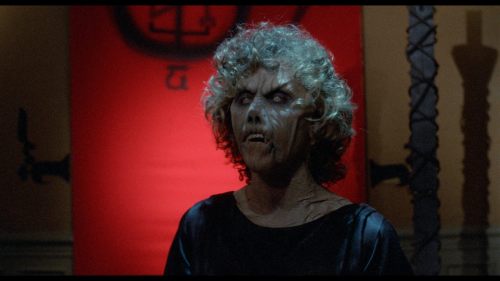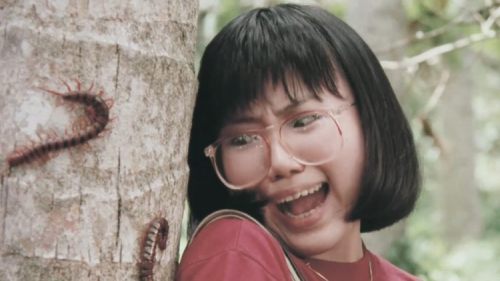Terror Tuesday: Is SAW the Biggest Horror Franchise To Respect Its Fans?
[caption id=“attachment_1808” align=“aligncenter” width=“568” caption=“Chester Bennington in SAW 3D”]
[/caption]
This past weekend, Saw 3D opened at #1, earning almost as much as Saw VI grossed in its entire run. There are a number of reasons for this – less competition (VI was up against both Paranormal Activity’s wide release as well as the poor reaction to Saw V, generally considered to be the weakest in the series), the higher 3D costs, and, most likely, the promise that this would be the final chapter, which no one really believed but likely inspired some curious viewers, wondering if this one had an actual ending for once instead of a cliffhanger.
And it did! Sort of. There was a bit of a question as to the identity of two characters aiding the “hero” during the climax, and the villain was inexplicably left alive, but at least we don’t have anything of major importance left unresolved. The authors of all secret notes have been revealed, the contents of mysterious packages shown (and used), and, finally, we know if Dr. Gordon is alive (spoiler: he is). But this isn’t a review of Saw 3D (if you want one, head over to Horror Movie A Day – beware of major spoilers though) – this is my thank you to Twisted and Lionsgate for having a lengthy and major horror franchise that never once betrayed fan loyalty and/or the work of the folks who created the previous installments.
Last week I wrote about Halloween 4, a film I really love that is part of a series I consider myself a fan of. But it’s not easy to love the Halloween series. Part III takes place in another universe entirely, part 6 chalked up just about everything that happened to a bunch of hooey involving druids and star patterns, H20 told us that parts 4-6 never happened, Resurrection ruined the awesome climax of H20 in order to make the undisputed worst entry yet… and then Rob Zombie came along. I mean, YIKES. Then we have the Friday the 13th series, which kept some continuity with regards to Jason – he would always be resurrected from the spot he died in the previous movie – but constantly changed just about everything else, including the location of Crystal Lake itself (CT or NJ, depending on the entry). And Jason Goes To Hell ignored pretty much everything up to that point, saving only the fact that there’s a guy in a hockey mask named Jason.
(We shouldn’t even get STARTED on the Texas Chainsaw series – how many different families does Leatherface have, exactly?)
[caption id=“attachment_1809” align=“aligncenter” width=“568” caption=“Tobin Bell in the poster for SAW V”]
[/caption]
This sort of thing always bothered me as a fan. I LIKED having characters return, cliffhangers on the end of an entry, etc. Even if I hated the druid nonsense of Halloween 6, I think it deserved to be wrapped up, not dropped and basically erased from existence (taking Donald Pleasence’s final role with it). What I didn’t want is something like Freddy’s Dead, where he’s back alive at the beginning with no explanation how he was resurrected, and a whole new cast of characters being introduced with no mention of the survivors from the previous film. I liked being rewarded for sticking around, but it seems every series always reached a point where the filmmakers didn’t want to bother with at least some of what came before, and picked up the “story” from an earlier movie at random. It’s a slap in the face to the people who made those movies, I think, not to mention a real burn to fans. I remember sitting down for Jason Goes To Hell, expecting some cool explanation for how he got back to Crystal Lake (and full sized again!), only for the events of the previous film to be ignored entirely. Plus, I instead got a finale with a bunch of supernatural nonsense (and an almost total lack of Jason) – what the hell, man? I’m here on opening day to see my beloved serial killer get his final sendoff, and it barely even feels like a slasher movie, let alone a Friday the 13th.
But the Saw series always kept everything consistent, story and production wise (the strength of each film’s story compared to others is up for debate, I’m not talking about that sort of stuff). The story was always being followed from the previous film, the characters returned time and time again, and you have to really get nitpicky to find plot holes in terms of a film saying one thing and a sequel showing another, which is even more impressive when you consider how many things get resolved 2-3 films after they were set up. For example, in Saw VI, we discover the contents of a note left for Amanda, something that happened in Saw III. And it holds up when you re-watch the films to boot! The biggest blunder is probably Adam’s last name, which inexplicably changed over the series. Everything else held up – one could create a timeline of the series as a whole (if you haven’t watch any of them – flashbacks play a big part, with one film even taking place simultaneously with the one before it) and not be left with any major holes. Ever try to map out the Friday the 13th series? Have fun trying to sort that mess.
[caption id=“attachment_1812” align=“aligncenter” width=“568” caption=“Just hanging around in SAW III”]
[/caption]
And can you name one other horror franchise of seven films or more that had the same primary cast for the main roles? Tobin Bell of course appeared in all films, but Costas Mandylor, Shawnee Smith, and Betsy Russell all appeared in 4-5 films each, and Dina Meyer, Donnie Wahlberg, and Lyriq Bent appeared in three. Not to mention various minor characters who’d pop up again and again, like the coroner dude who claims to have worked on every Jigsaw victim. Christ, Friday the 13th couldn’t even keep one Tommy Jarvis from film to film, and Kane Hodder was the only guy to ever play Jason more than once. But in the Saw films, no one was ever recast, and no major character ever dropped from the series without explanation (of course, most of them were DEAD, but still). Freddy and Pinhead were always played by the same guy (until this year anyway), and each had a recurring nemesis (Nancy and Kirsty, respectively), but otherwise there was no sense of an organic thru-line that connected all entries.
The crew also remained constant. Original creators James Wan and Leigh Whannell remained with the series until III, and each subsequent entry was written by Marcus Dunstan and Patrick Melton, and directed by someone who had been with the series for a long time, if not the beginning. IV was delivered by Darren Bousman, who had helmed Saw II and III, David Hackl (production designer and 2nd unit director on Saw II-Saw IV) directed V, and Kevin Greutert (editor: Saw I-Saw V) directed the final two installments. And the crew was pretty consistent: David Armstrong was the DP on the first six entries, Charlie Clouser composed the score for all of them, and even the same costume designer (Alex Kavanaugh) provided those ever bloodied clothes for every sequel. In short, there was never a time where a whole new crew came in and changed things up or tried to reinvent the series – it was almost like a serialized TV show (24, Lost) when it came to consistency. You can watch the entire series back to back without getting whiplash.
Again, this is not me defending them from a critical standpoint (though I DO like them quite a bit), I am defending them as a horror fan who is usually burned by a series the further along it gets. Halloween fans were constantly being told that previous films didn’t matter or didn’t happen, but the Saw producers never shat on their fans like that. If you were a fan, each film rewarded your loyalty. It probably wasn’t cheap to get Cary Elwes back for Saw 3D (plus it was probably kind of awkward – the guy sued them a few years ago over a salary issue), but they knew that if this was indeed the last film, they owed it to the faithful to wrap up his storyline, and do so without tossing some other actor into the role, like every single other series would have done. You don’t believe me? Ask Danielle Harris how much she asked for to be in Halloween 6, which Dimension refused to pay (hint: it was pretty goddamn low). Instead, they got some other girl, which obviously didn’t sit well with fans.
[caption id=“attachment_1814” align=“aligncenter” width=“568” caption=“Cary Elwes in the first SAW”]
[/caption]
It’s a shame that this is the exception, rather than the rule. It’s certainly not the most critically acclaimed series of all time, and seems to inspire an unreasonable amount of hatred from its detractors (including some who haven’t even seen the films), and yes, they churned them out year after year without a break, which is apparently a bad thing (considering even haters acknowledge how well Saw VI turned out creatively, apparently it wasn’t too big of a deal for the crew). How great would it have been if Hellraiser or Nightmare on Elm St, which brought a little more critical respect than most horror series, had this strong of a connective tissue throughout, with Clive Barker or Wes Craven (or at least, their chosen replacements) sticking around for the long haul? Scream seems to be on this sort of track, but will it reach Scream 7 (or even 5) with that much continuity on and off camera?
Like them or not, one thing is certain: ultimately (and maybe it will take a few years to be truly appreciated for it), the Saw team gave horror fans a bit of the respect we’re constantly being denied by the other big franchises, period. And as much as I’d love some more adventures and crazy mythology revelations (no one ever turned out to be someone’s brother or sister, shockingly enough), I would be happy to see it end here and keep its (relative) dignity intact, because we’re not likely to have another horror series of this magnitude put its fans and storyline first ever again. You can hate the films all you want, but at least give them credit for that much.


